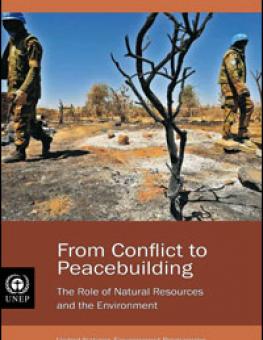
From Conflict to Peacebuilding: The role of natural resources and the environment
Since 1990 at least eighteen violent conflicts have been fuelled by the exploitation of natural resources. In fact, recent research suggests that over the last sixty years at least forty per cent of all intrastate conflicts have a link to natural resources.
Since 1990 at least eighteen violent conflicts have been fuelled by the exploitation of natural resources.
In fact, recent research suggests that over the last sixty years at least forty per cent of all intrastate conflicts have a link to natural resources. Civil wars such as those in Liberia, Angola and the Democratic Republic of Congo have centred on "high-value" resources like timber, diamonds, gold, minerals and oil. Other conflicts, including those in Darfur and the Middle East, have involved control of scarce resources such as fertile land and water.
As the global population continues to rise, and the demand for resources continues to grow, there is significant potential for conflicts over natural resources to intensify in the coming decades. In addition, the potential consequences of climate change for water availability, food security, prevalence of disease, coastal boundaries and population distribution may aggravate existing tensions and generate new conflicts.
This major report, co-authored by IISD and UNEP, discusses the key linkages among environment, conflict and peacebuilding, and provides recommendations on how these can be addressed more effectively by the international community.
Key points:
Environmental factors are rarely, if ever, the sole cause of violent conflict. However, the exploitation of natural resources and related environmental stresses can be implicated in all phases of the conflict cycle, from contributing to the outbreak and perpetuation of violence to undermining prospects for peace.
In addition, the environment can itself fall victim to conflict, as direct and indirect environmental damage, coupled with the collapse of institutions, can lead to environmental risks that threaten people's health, livelihoods and security.
Preliminary findings from a retrospective analysis of intrastate conflicts over the past sixty years indicate that conflicts associated with natural resources are twice as likely to relapse into conflict in the first five years. Nevertheless, fewer than a quarter of peace negotiations aiming to resolve conflicts linked to natural resources have addressed resource management mechanisms.
The recognition that environmental issues can contribute to violent conflict underscores their potential significance as pathways for cooperation, transformation and the consolidation of peace in war-torn societies.
Natural resources and the environment can contribute to peacebuilding through economic development and the generation of employment, while cooperation over the management of shared natural resources provides new opportunities for peacebuilding.
Integrating environment and natural resources into peacebuilding is no longer an option—it is a security imperative. The establishment of the UN Peacebuilding Commission provides an important chance to address environmental risks and capitalize on potential opportunities in a more consistent and coherent way.
Key recommendations:
- Further develop UN capacities for early warning and early action
- Improve oversight and protection of natural resources during conflicts
- Address natural resources and the environment as part of the peacemaking and peacekeeping process
- Include natural resources and environmental issues into integrated peacebuilding strategies
- Carefully harness natural resources for economic recovery
- Capitalize on the potential for environmental cooperation to contribute to peacebuilding
You might also be interested in
Will the Inclusion of Voluntary Standards in Trade Agreements Lead to More Sustainable Trade?
The use of voluntary sustainability standards (VSSs) and similar systems in free trade agreements (FTAs) is gaining traction. Will it lead to more sustainable production and consumption globally?
Strategic Environmental Assessment for the Mining Sector
Strategic environmental assessments (SEA) are an essential tool for policy-makers working to develop a sector-wide vision for responsible mining.
Blackouts and Backsliding: Energy subsidies in South Africa 2023
Blackouts and Backsliding presents the latest energy subsidy data for South Africa.
Sustainable Asset Valuation of Parques del Río Norte in Medellín, Colombia
This economic valuation demonstrates the benefits of expanding urban green space in the city of Medellín, Colombia.